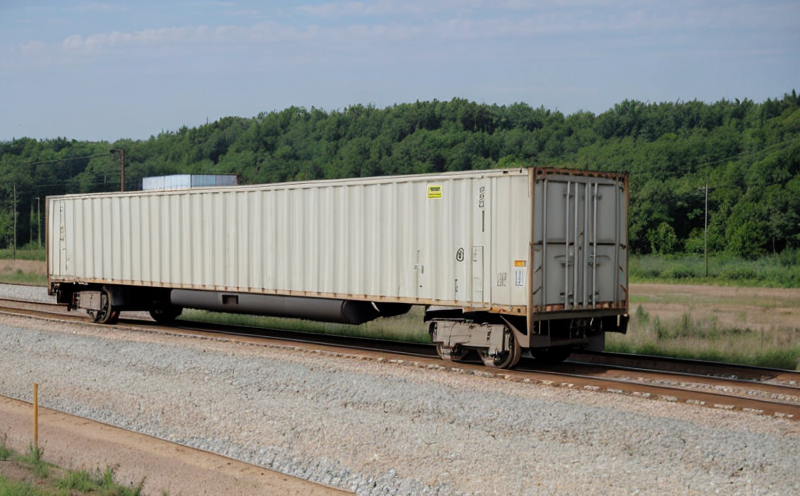EN 15227 Energy Absorption Testing of Buffers and Couplers
The European Standard EN 15227 is pivotal in ensuring the safety, reliability, and durability of railway buffers and couplers used in cargo and freight wagons. This standard specifically addresses energy absorption properties, which are critical for mitigating impacts during train operations. The tests prescribed by this standard simulate real-world conditions to evaluate how well a buffer or coupler can absorb kinetic energy during collisions.
The primary focus of EN 15227 is on the energy absorption characteristics under various test conditions, including static and dynamic loading scenarios. This ensures that the buffers and couplers perform optimally in both normal operation and potential collision situations. The standard covers a range of tests designed to assess how well these components can withstand the forces exerted during coupling or uncoupling operations.
The testing procedure involves placing the buffer or coupler between two rigid supports, subjecting it to controlled impacts at specified velocities. The energy absorbed by the buffer is then measured and compared against predefined criteria. This measurement allows for a quantitative assessment of the buffer's performance in absorbing kinetic energy during collisions.
In addition to energy absorption, EN 15227 also addresses other aspects such as durability, wear resistance, and the ability to maintain performance over extended periods. These factors are crucial for ensuring that buffers and couplers can continue to function safely and effectively throughout their operational lifespans.
The importance of this testing cannot be overstated in the railway industry. The safety implications of poorly designed or inadequate buffers and couplers could lead to catastrophic failures, resulting in significant damage to both the wagons and surrounding infrastructure. Furthermore, such failures can pose a serious risk to passenger and freight operations, leading to delays, increased maintenance costs, and potential legal liabilities.
The tests prescribed by EN 15227 are not only essential for ensuring compliance with European regulations but also play a vital role in the design and development of safer and more efficient railway systems. By adhering to this standard, manufacturers can demonstrate their commitment to quality and safety, thereby enhancing the overall reliability of railway operations.
Understanding the specific requirements and procedures outlined in EN 15227 is crucial for any organization involved in the production or testing of railway buffers and couplers. This knowledge allows stakeholders to make informed decisions about design choices, material selection, and manufacturing processes, ultimately leading to higher-quality products.
The testing process itself involves several key steps: specimen preparation, instrumentation setup, data collection, and analysis. Specimens are carefully prepared according to the standard’s specifications, ensuring that they accurately represent real-world conditions. The use of advanced instrumentation allows for precise measurement of energy absorption metrics, providing accurate data for evaluation.
Data collected during these tests is critical for assessing compliance with EN 15227 and identifying any areas for improvement in design or manufacturing processes. This data-driven approach ensures that manufacturers can continuously refine their products to meet the highest standards of safety and performance.
In conclusion, EN 15227 Energy Absorption Testing of Buffers and Couplers is a cornerstone in ensuring the safe and efficient operation of railway systems. By adhering to this standard, organizations involved in the production and testing of buffers and couplers can demonstrate their commitment to quality and safety, thereby enhancing the overall reliability of railway operations.
Why It Matters
The importance of EN 15227 Energy Absorption Testing cannot be understated. This testing is crucial for several reasons:
- Safety First: Ensures that buffers and couplers can effectively absorb kinetic energy during collisions, reducing the risk of accidents.
- Durability and Reliability: Tests help in identifying weaknesses or areas for improvement to ensure long-term performance.
- Regulatory Compliance: Adherence to international standards like EN 15227 is a prerequisite for many railway systems, ensuring compliance with legal requirements.
- Economic Benefits: Prevents costly damage to wagons and infrastructure while minimizing downtime due to accidents or failures.
In summary, the tests conducted under EN 15227 are essential for maintaining high standards of safety, reliability, and compliance in railway operations. By investing in this testing process, organizations can ensure that they meet the necessary regulatory requirements while also enhancing their reputation as leaders in quality and innovation.
Applied Standards
EN 15227:2008 is the European standard specifically addressing energy absorption tests for buffers and couplers used in railway wagons. This standard provides detailed specifications on how to conduct these tests, including:
- Test setup and configuration
- Data collection methods
- Acceptance criteria
- Reporting requirements
The standard is designed to ensure that buffers and couplers are capable of absorbing energy effectively during collisions, thereby enhancing the safety and reliability of railway operations. It also covers various test scenarios to evaluate different aspects of buffer performance.
In addition to EN 15227, other relevant standards include:
- ISO 6482:2012 – Rail vehicles – Energy absorption by buffers
- ASTM E4394:2021 – Standard test method for energy absorption characteristics of railway coupler buffer systems
These standards, among others, provide comprehensive guidance on the testing and evaluation of railway buffers and couplers. By adhering to these international standards, organizations can ensure that their products meet the highest quality and safety requirements.
Why Choose This Test
Selecting EN 15227 Energy Absorption Testing for buffers and couplers is a strategic decision with numerous benefits:
- Regulatory Compliance: Ensures that products meet the required standards set by European regulations.
- Enhanced Safety: Tests help in identifying any potential weaknesses or areas for improvement, enhancing overall safety.
- Improved Durability: Identifies ways to improve durability and reliability of buffers and couplers.
- Competitive Edge: Demonstrates commitment to quality and innovation, providing a competitive advantage in the market.
In conclusion, choosing EN 15227 Energy Absorption Testing is not just about meeting regulatory requirements; it's also about ensuring that products meet the highest standards of safety, reliability, and durability. By investing in this testing process, organizations can enhance their reputation as leaders in quality and innovation.





